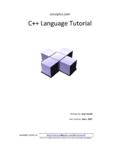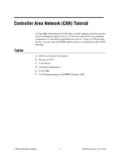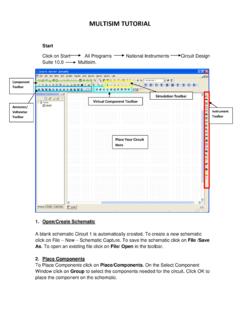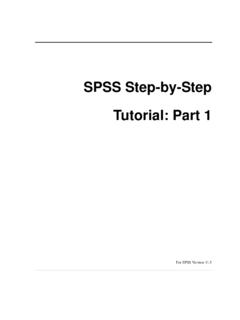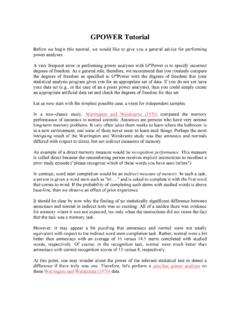Transcription of IP Address Subnetting Tutorial - First Net Security
1 IP Address Subnetting TutorialBy Ralph September 7, 1999 This copy distributed by FirstVPN with author's the information contained in this Tutorial is provided for the convenience of its readers. All informationis accurate as well as can be reasonably verified. There are no guarantees or warranties stated orimplied by the distribution of this information. Use the information in this document at the reader's ownrisk, and no liability shall be given to the author. Any damage or loss is the sole responsibility of Notice and Distribution PermissionCopyright 1996-2000 by Ralph Becker, All Rights links to this site are encouraged.
2 Hard copy reproduction created by printing each page of thetutorial is permitted. Online reproduction of the content of this Tutorial beyond the control of the author isnot permitted without express permission. Distribution for profit or financial gain is not in commercial collections, compilations, or books without express permission from the authoris not IntroductionIP AddressingSubnettingMore Restrictive Subnet MasksAn ExampleCIDR -- Classless InterDomain RoutingAllowed Class A Subnet and Host IP addressesAllowed Class B Subnet and Host IP addressesAllowed Class C Subnet and Host IP addressesLogical OperationsReferences and Sources on the InternetIntroductionThis talk will cover the basics of IP addressing and Subnetting .
3 Topics covered will include: What is an IP Address ? What are Classes? What is a Network Address ? What are Subnet Masks and Subnet Addresses? How are Subnet Masks defined and used? How can all this be applied? What is CIDR?IP AddressingAn IP (Internet Protocol) Address is a unique identifier for a node or host connection on an IP network. AnIP Address is a 32 bit binary number usually represented as 4 decimal values, each representing 8 bits, inthe range 0 to 255 (known as octets) separated by decimal points. This is known as "dotted decimal" : is sometimes useful to view the values in their binary.
4 179 .220 . IP Address consists of two parts, one identifying the network and one identifying the node. TheClass of the Address and the subnet mask determine which part belongs to the network Address andwhich part belongs to the node ClassesThere are 5 different Address classes. You can determine which class any IP Address is in by examiningthe First 4 bits of the IP Address . Class A addresses begin with 0xxx, or 1 to 126 decimal. Class B addresses begin with 10xx, or 128 to 191 decimal. Class C addresses begin with 110x, or 192 to 223 decimal.
5 Class D addresses begin with 1110, or 224 to 239 decimal. Class E addresses begin with 1111, or 240 to 254 beginning with 01111111, or 127 decimal, are reserved for loopback and for internal testing ona local machine. [You can test this: you should always be able to ping , which points to yourself]Class D addresses are reserved for multicasting. Class E addresses are reserved for future use. Theyshould not be used for host we can see how the Class determines, by default, which part of the IP Address belongs to thenetwork (N) and which part belongs to the node (n).
6 Class A -- Class B -- Class C -- the example, is a Class B Address so by default the Network part of the Address (alsoknown as the Network Address ) is defined by the First two octets ( ) and the node part isdefined by the last 2 octets ( ).In order to specify the network Address for a given IP Address , the node section is set to all "0"s. In ourexample, specifies the network Address for When the node section is setto all "1"s, it specifies a broadcast that is sent to all hosts on the network. specifies theexample broadcast Address .
7 Note that this is true regardless of the length of the node an IP Network can be done for a variety of reasons, including organization, use of differentphysical media (such as Ethernet, FDDI, WAN, etc.), preservation of Address space, and Security . Themost common reason is to control network traffic. In an Ethernet network, all nodes on a segment see allthe packets transmitted by all the other nodes on that segment. Performance can be adversely affectedunder heavy traffic loads, due to collisions and the resulting retransmissions. A router is used to connectIP networks to minimize the amount of traffic each segment must MaskingApplying a subnet mask to an IP Address allows you to identify the network and node parts of theaddress.
8 Performing a bitwise logical AND operation between the IP Address and the subnet mask resultsin the Network Address or example, using our test IP Address and the default Class B subnet mask, we Class B IP Default Class B Subnet Network AddressDefault subnet masks: Class A - - Class B - - Class C - - More Restrictive Subnet MasksAdditional bits can be added to the default subnet mask for a given Class to further subnet, or breakdown, a network. When a bitwise logical AND operation is performed between the subnet mask and IPaddress, the result defines the Subnet Address .
9 There are some restrictions on the subnet Address . Nodeaddresses of all "0"s and all "1"s are reserved for specifying the local network (when a host does notknow it's network Address ) and all hosts on the network (broadcast Address ), respectively. This alsoapplies to subnets. A subnet Address cannot be all "0"s or all "1"s. This also implies that a 1 bit subnetmask is not allowed. This restriction is required because older standards enforced this restriction. Recentstandards that allow use of these subnets have superceded these standards, but many "legacy" devicesdo not support the newer standards.
10 If you are operating in a controlled environment, such as a lab, youcan safely use these restricted calculate the number of subnets or nodes, use the formula (2^n - 2) where n = number of bits in eitherfield. Multiplying the number of subnets by the number of nodes available per subnet gives you the totalnumber of nodes available for your class and subnet mask. Also, note that although subnet masks withnon-contiguous mask bits are allowed they are not IP Subnet Subnet Broadcast AddressIn this example a 3 bit subnet mask was used.

